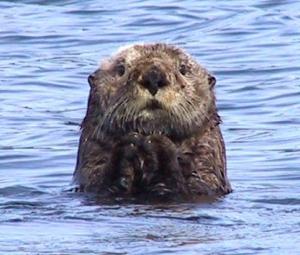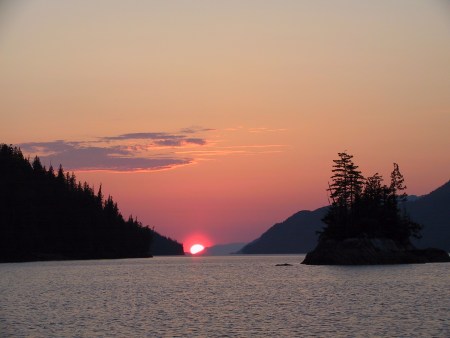Reid Glacier, Glacier Bay National Park
Even though I have a power boat now, a sure sign of a lazy person, I'm not ready to give up all physical activity.
I don't own an outboard engine for my dinghy, and when I cruise I take a kayak, my rollerblades, and a bicycle. And — I use them!
I have had several kayaks over the years, finally settling on a Kevlar boat made by Seda, "Viking," 38 pounds empty. I have been visiting a lot of fresh-water lakes from the boat lately, so I have a set of wheels that makes it relatively easy to transport the kayak from a salt-water bay to a fresh-water lake or sometimes a lagoon, by way of a trail.
I always explore new places with the kayak, because you see and hear so much more than you can from a yacht. Almost all my recent bear close encounters have been from the kayak, because it is a small, unobtrusive way to visit wildlife areas. And there's the advantage that the bear cannot get to you (usually, unless you plant yourself against the shore). And bears don't generally feel threatened by something that is offshore, especially something small and quiet like a kayak.
I sometimes visit a rather neat floating resort at Glendale Cove (on Knight Inlet, B.C.) that specializes in showing bears to their clients (more detail
here
). Well, they tell me the problems caused by cameras are so severe that they don't allow clients to take cameras with them on bear outings.
"What is that weird, skinny boat?"
Sea Otter, Kodiak Island
But I carry a camera on the kayak, in a waterproof bag. And I don't let the camera disturb the bears.
I have completely gotten away from film cameras over the past few years, as digital camera technology has improved. During this trip I carried a Canon PowerShot Pro 90IS. It has a 10x zoom, a feature I regard as very important (I would much rather zoom in on an 800 pound grizzly than paddle in on one).
The camera also has enough selectable options that you can disable the flash (absolutely essential for bear photography) as well as silence the default shutter sound, resulting in a totally silent camera that doesn't flash a light at the bear.
As time passes, cameras become more versatile and adaptable, and the one I have now meets most of my requirements (silent, no flash, acceptable zoom), but most of them still have a very annoying trait — the picture is not taken when the shutter button is pressed, but a second or two later. I hope the camera companies fix this problem sometime soon. This annoying time delay is why I have no decent whale pictures from this voyage — I would see a whale, punch the button, but by the time the picture was actually taken, the whale was gone.
Sunset at Klewnuggit Inlet
I have a 128 MB memory card on my camera, which means I can take 147 pictures with a very good level of detail (none of the pictures in this article are at the original full resolution, because they would take too long to download). This is a world of difference when compared to old-fashioned film photography. With that storage capacity, I can snap away, knowing I can simply erase all the duds, either right there in the kayak, or later on when editing the pictures in the computer.
Also, because of the technical nature of digital photography, it is possible to change the brightness and contrast of an image after the picture has been taken, with little or no loss of information. I have frequently rescued a nice image that was too bright or dim overall. This is true because of digital image sensors, which have a much higher contrast ratio than film does.
Now, compare this new technology to the old, the one I had to use during my around-the-world sail 14 years ago. As one example, I sailed across the Indian Ocean, taking many nice pictures as I went. I arrived in Sri Lanka and put my rolls of film in an envelope to mail home to Oregon. My film was normally developed at home and saved for my return. What I didn't know was there was a scam in the Sri Lankan post office — someone would tear open any envelopes containing film canisters, use a pair of tweezers to retrieve the end of the film (to make the canister look unused), and re-sell the exposed film to some unsuspecting tourist. I lost several rolls of film in just that way.
And the difference? Look at the picture to the right. I took about 35 pictures of this sunset over a period of two hours, as the sun moved across the evening sky. Then, after the sun set, I simply chose the picture I liked the best. Imagine how much trouble that would have been if I had used a film camera.
So, to summarize the advantages of digital photography: more pictures, better pictures, less waste, and no trip to the drugstore.


 Share This Page
Share This Page

 Share This Page
Share This Page




 Share This Page
Share This Page